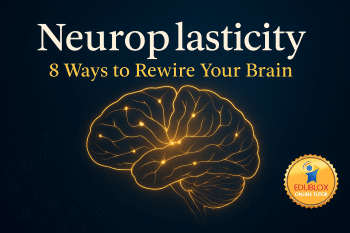
It was long believed that once we grow up, our brains have a set number of neurons performing functions in a fixed way. In the past two decades, however, neuroscientists have dismantled, piece by piece, the entrenched view that the human brain is fixed and unchanging in adults.
A growing number of research publications have illustrated the remarkable ability of the brain to reorganize itself in response to various sensory experiences.
Table of contents:
- What is neuroplasticity?
- Neuroplasticity and the human brain
- Ways to rewire your brain
- Use it or lose it
- Key takeaways
What is neuroplasticity?
Neuroplasticity or brain plasticity refers to the brain’s ability to modify, change, and adapt both structure and function throughout life and in response to experience. Canadian psychiatrist Norman Doidge has called neuroplasticity one of the most extraordinary discoveries of the twentieth century.
The brain is plastic throughout life – it is constantly changing. Changes associated with learning occur mostly at the level of the connections between neurons – new connections can form, and the internal structure of the existing synapses can change. New neurons are constantly being born, particularly in the learning and memory centers. When you become an expert in a specific domain, the areas in your brain that deal with this type of skill will grow.
Our understanding of brain plasticity has its roots in animal brain research conducted in the 1950s, which was designed to investigate whether the environment had any effect on the structure and function of the animal brain. Researchers studied rodents raised in two distinct environments: enriched and unenriched. The animals raised in unenriched environments were isolated and had no running wheels or toys to play with. When the two groups of rodents were compared following an autopsy, results yielded significant differences in their brains. The rodents raised in an enriched environment had a larger cortex, more cellular connections (synapses that lead to brain reserve), and the formation of new brain cells (neurogenesis) in the hippocampus (the structure critical to new learning and memory).
While the research offered highly significant and important findings regarding the effect of the environment on brain structure in animals, the critical issue of whether the same findings could be established for humans remained unknown until 1998.
Neuroplasticity and the human brain
A 1998 landmark study found that the human brain had the ability to develop new brain cells. This research challenged the prevailing theory that the human brain was a rigid system with no ability to generate new brain cells. Previously, most experts believed that humans were born with all of their brain cells, that we lose brain cells on a daily basis, and that our brains do not generate or replace the lost cells with new ones.
Many research studies followed, demonstrating the plasticity of the brain.

A study in 2000 discovered that London taxi drivers have a larger hippocampus, a brain structure known to be heavily involved in learning routes and spatial representations, than London bus drivers. Furthermore, the study found that the hippocampus’s size correlated with the time being a taxi driver, suggesting that driving taxis may develop and change the hippocampus.
Draganski and colleagues showed that extensive learning of abstract information could trigger changes in the brain. They imaged the brains of German medical students three months before their medical exam and right after the exam and compared them to the brains of students who were not studying for an exam. Medical students’ brains showed learning-induced changes in regions of the parietal cortex and the posterior hippocampus. These brain regions are known to be involved in memory retrieval and learning.
Ways to rewire your brain
We cannot all become taxi drivers and medical doctors. Fortunately, there are easier ways to take advantage of brain plasticity:
1. Eat well, live well
An international team of researchers found that seniors who consumed the most nutritious food had a nearly 25 percent reduction in the risk of mental decline compared to those with the least healthy diets. This study was published in the online issue of Neurology. The researchers followed 27,860 people aged 55 or older from 40 different countries for an average of about five years. Everyone in the study had either diabetes or a history of heart disease, stroke, or peripheral artery disease.
Over the course of the study, 4,699 people suffered a decline in thinking and memory. Those consuming the most nutritious diets were 24 percent less likely to have cognitive declines than those consuming the least healthy foods. The results didn’t change when researchers accounted for factors that might impact cognitive health, including physical activity, high blood pressure, and a history of cancer.
2. Nap during the day
University of Berkeley researchers challenged a group of thirty-nine young adults to a tough learning task designed to give their memory skills a workout. Half of the group took a ninety-minute nap two hours later while the other remained awake. Again, both groups were asked to learn a new set of learning skills. Which group did better? The young adults who napped after the first learning task improved their brain and memory skills the second time around, while the group who stayed awake had more learning and memory difficulties.
3. Get physical
A study led by Arthur F. Kramer of the University of Illinois at Urbana-Champaign involved well-educated men and women aged 55 to 79. Their fitness ranged from sedentary to very fit, competitive-ready athletes. While older adults show a decline in brain density in white and gray areas, the researchers discovered that fitness slows that decline.
Exercise programs involving aerobic exercise and strength training produced better cognitive abilities results than either alone.
 4. Learn to juggle
4. Learn to juggle
University of Regensburg neurologist Arne May and colleagues asked 12 people in their early twenties, most of them women, to learn a classic three-ball juggling trick over three months until they could sustain a performance for at least a minute. Another 12 were a control group who did not juggle. All the volunteers were given a brain scan with magnetic resonance imaging (MRI) at the program’s start and a second after three months.
The scans found that learning to juggle increased the volume of gray matter in the mid-temporal area and left posterior intra-parietal sulcus by about three percent. These are parts of the left hemisphere of the brain that process data from visual motion. Students who had not undergone juggling training showed no such change.
5. Learn a new language
Researchers at University College London studied the brains of 105 people, 80 of whom were bilingual, and found that learning a new language altered gray matter the same way exercise builds muscles. Moreover, those who learned a second tongue at a younger age were also more likely to have more advanced gray matter than those who learned later.
6. Play a musical instrument
Playing an instrument can go straight to a musician’s head, scientists have revealed. A study by researchers at Liverpool University has shown that practice and performance prevent a vital part of the brain from shrinking with age. Musicians in the Royal Liverpool Philharmonic Orchestra were found to have an average of 15 percent more gray matter in the brain region than nonmusicians. The part of the brain involved, called Broca’s area, deals with memory, language processing, and organization.
7. Meditate
Even thinking can change the brain! One experiment involved a group of eight Buddhist monk adepts and ten volunteers who had been trained in meditation for one week. All the people tested were told to meditate on compassion and love. Two controls, and all the monks, experienced an increase in the number of gamma waves in their brain during meditation.
As soon as they stopped meditating, the volunteers’ gamma wave production returned to normal. In contrast, the monks, who had meditated on compassion for more than 10,000 hours to attain the rank of adept, did not experience a decrease to normal in the gamma wave production after they stopped meditating. The synchronized gamma wave area of the monks’ brains during meditation on love and compassion was found to be larger than that corresponding activation of the volunteers’ brains.
8. Give your brain a workout
In the same way that regular physical workouts keep the body limber and healthy, regular mental and neurological workouts help keep your mind and nervous system in good working order.
Use it or lose it
Exercising or stimulating your brain is highly recommended as part of a brain-healthy lifestyle. Brain exercises impact brain health, thanks to the brain’s plasticity. When you exercise or stimulate your brain through new or unfamiliar activities, you can trigger changes in the brain, such as increased connections between neurons. These changes contribute to an increase in what is called your brain reserve. Research suggests that the more brain reserve, the more resistant the brain is to age-related or disease-related damage.
To better understand brain reserve, consider the following scenario: You fly 1000 feet above the ground in an airplane. Looking down, you see two different scenes. The first scene is a jungle with so many trees you cannot see the ground. The second scene is an island with one palm tree blowing slowly in the wind.
A healthy brain should be like a jungle, with a tremendous number of synaptic connections. This is referred to as synaptic density and is a direct measure of brain reserve. A brain should not look like an island with one palm tree. The reason is simple. Alzheimer’s disease and other types of dementia will invade the brain and begin to cut down the neurons and synaptic connections, like a weed-whacker cutting through the weeds around your house. If the brain looks like a jungle, filled with synaptic connections, Alzheimer’s and other diseases will take a long time to show their ugly clinical face. However, if the brain looks like the island with one palm tree, the clinical signs of Alzheimer’s will manifest quickly because there is no reserve to fight it off.
Indeed, some research has shown that even though brains are diagnosed with Alzheimer’s disease at autopsy due to neuropathological changes, a significant number of these persons never demonstrated the clinical aspects of the disease in life. That is because they had built up brain reserve to fight off or delay the onset of the disease.
University of N.S.W. neuroscientist Michael Valenzuela and colleague Perminder Sachdev concluded that people with high brain reserve have almost half as much risk of developing dementia as those with low brain reserve. In one sense, the brain appears to be no different from the muscles of the body, said Valenzuela: “It’s a case of use it or lose it.”


